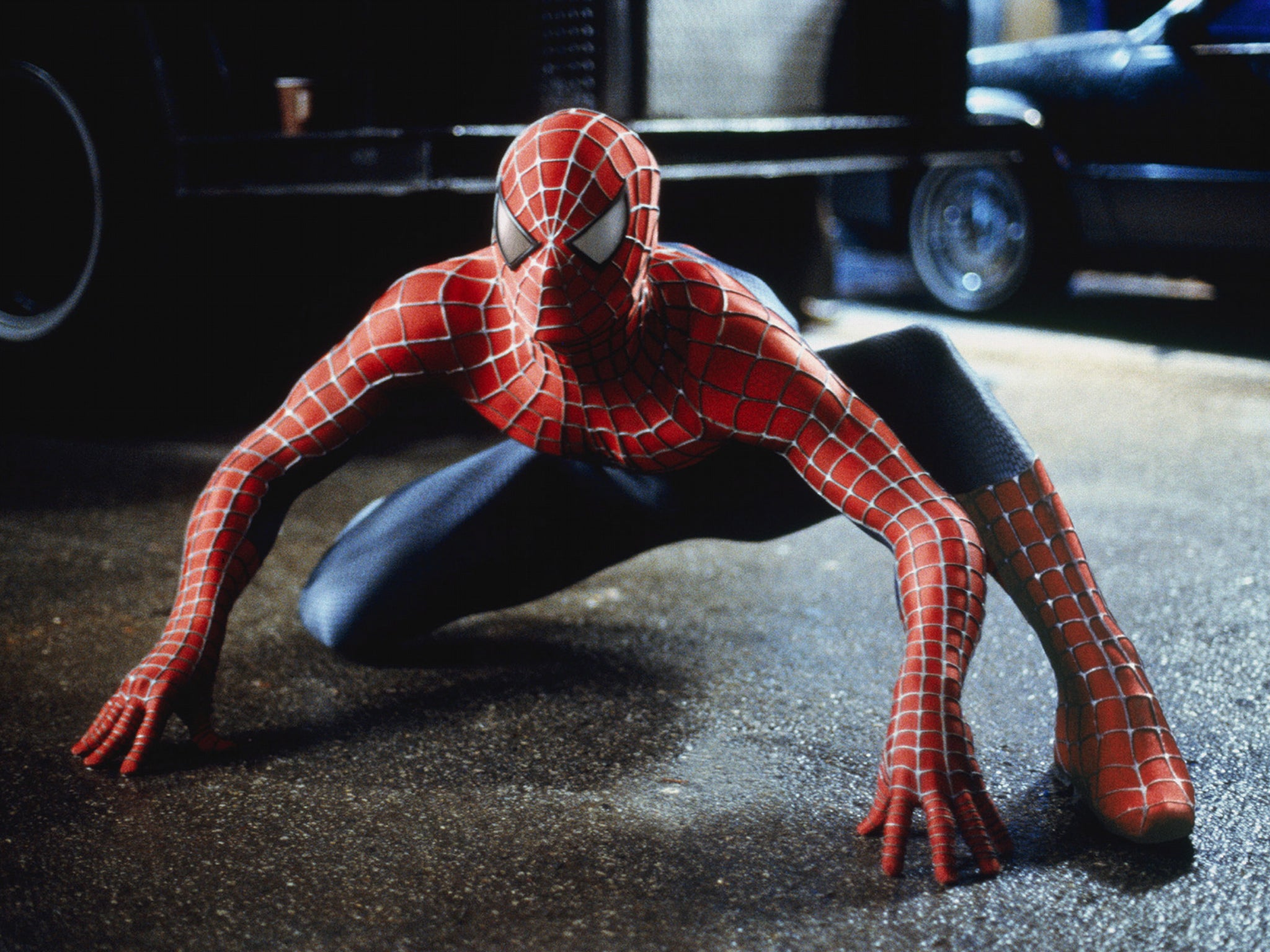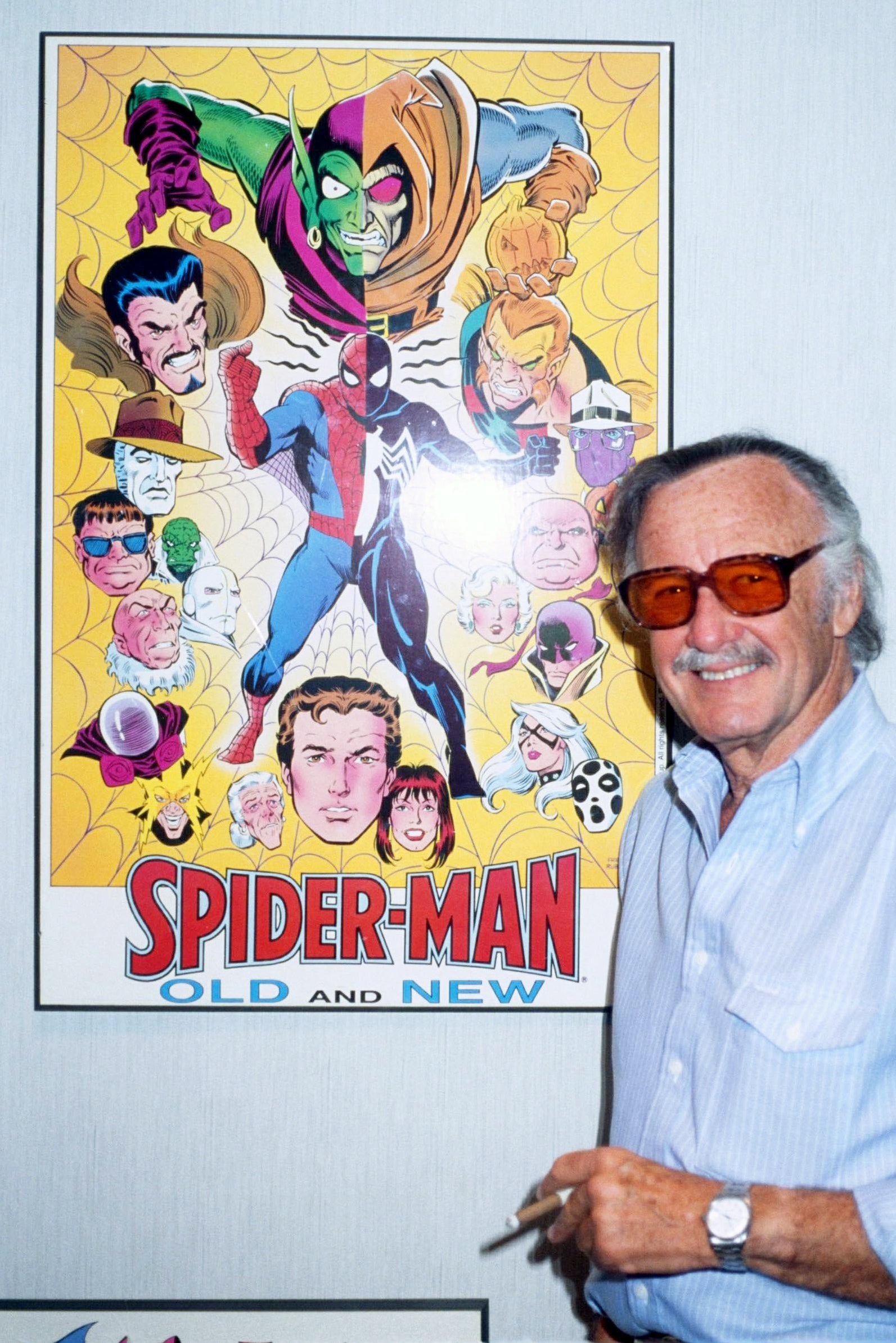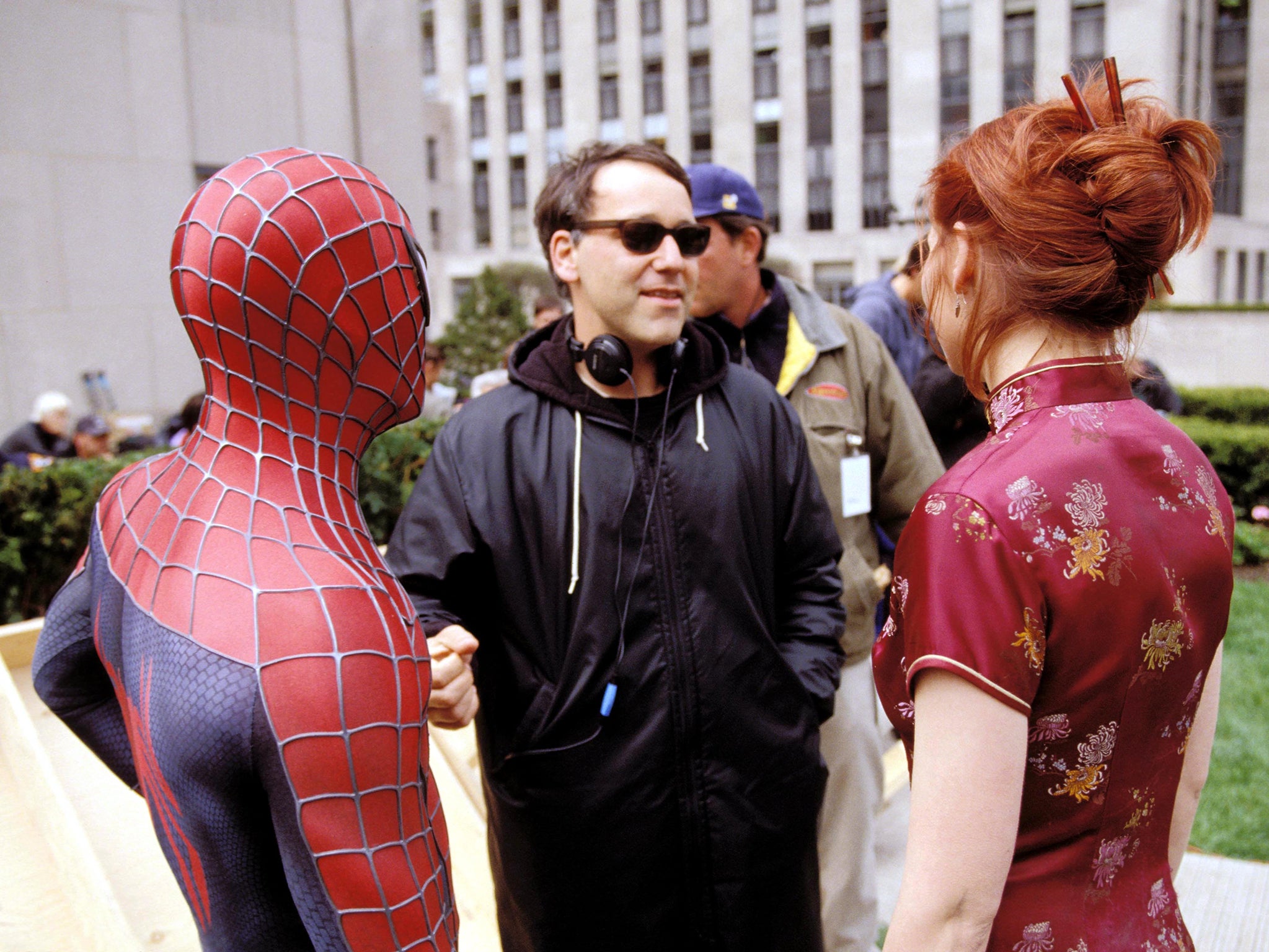Along came a Spider-Man: How Sam Raimi reinvented superhero cinema forever
As the director makes his return to superhero blockbusters with ‘Doctor Strange in the Multiverse of Madness’, Ed Power tells the story of the unlikely franchise that put masked crusaders on the map

Twenty years ago, cinema received a radioactive bite from which it has yet to fully recover. On 3 May 2002, Sam Raimi’s Spider-Man swung into multiplexes. By the time it had swung out again, the ground had shifted for big-screen superheroes and for the movie-going experience itself. Spidey was always one of the nerdier members of the spandex crime-fighter club. But it is no exaggeration to say that, with his first blockbuster film, he and Raimi changed everything for popcorn culture.
Raimi has stayed away from superheroes since completing his Spidey trilogy with Spider-Man 2 (2004) and Spider-Man 3 (2007), but he finally returns to the “biff-pow” realm this week for his Marvel Cinematic Universe debut, Doctor Strange in the Multiverse of Madness, the sequel to 2016’s Doctor Strange. It’s a homecoming of sorts for the director, returning to a school of filming whose brash aesthetics he did so much to shape.
The Marvel Cinematic Universe (MCU) arguably owes its entire existence to what Raimi achieved with his bold, bouncy and irresistibly breezy Spider-Man. Much as Spidey saves love interest Mary Jane from the clutches of the Green Goblin, so the director sprang superhero cinema free from the shackles of Hollywood and brought it to a place of pure fun and excitement. In doing so, he built a franchise that true geeks could love wholeheartedly. Raimi may be only now joining the MCU – but make no mistake, the MCU is forged in his image.
Let us rewind for a moment. By the early Noughties, superhero films were regarded as a dead genre walking. The late Nineties had been a dire period for these movies. Joel Schumacher’s disastrous Batman & Robin – featuring George Clooney in a nipple-tastic Batman costume – had killed off the Nineties comic-book boom single-handed. Though Bryan Singer’s X-Men had put cowled vigilantes back on the radar in 2000, it was regarded as an auteurist one-off – a superhero flick that had triumphed because of its once visionary (if now disgraced) director. And despite its proliferation of characters flying around shooting laser beams from their eyes.
Besides, the X-Men, and characters such as Wolverine and Magneto, had an outlaw swagger. Spider-Man was a confused adolescent climbing buildings. A big-screen adaptation had all the makings of a friendly neighbourhood fiasco. And yet Raimi spun box office gold out of the tale of teenage web-slinger Peter Parker. It opened a chapter in cinema history that we are still very much living through.
What made it golden? With the triple-threat casting of Maguire as the wholesome Parker, Kirsten Dunst as girl-next-door love interest Mary Jane, and Willem Dafoe as a cackling Green Goblin, Spider-Man was a romp. Everybody involved looked like they were having fun and buying into the perky qualities of the Spider-Man comic strip. As the villain, Dafoe in particular indulged in more than a little scenery-chewing. It was a blockbuster that asked nothing of the audience other than that they enjoy themselves.
That larkish quality was a signature of Raimi’s. He burst onto the screen in 1982 with his schlocky horror The Evil Dead, a knowingly over-the-top zombie film that, though shot on a shoestring, was animated by an irresistible giddiness. Raimi was a technically accomplished director – 1985’s follow-up Evil Dead 2 featured innovative camera-work and accomplished use of gore. But above all, his best work – and Spider-Man is right up there – is just great fun.
The mere fact of the Spider-Man movie’s existence was miraculous. Efforts to bring Marvel father-figure Stan Lee’s adolescent crime-fighter to the screen had been ongoing for more than a decade. At the time, nobody would have believed that the character would spawn three separate franchises (with Andrew Garfield and Tom Holland taking over from Maguire – and all three uniting for last year’s multidimensional Spider-Man: No Way Home).
There were a few forays into farce along the way. The chipper teenage hero had actually come terrifyingly close to being repurposed as a David Cronenberg-style horror in the 1980s. That was when Menahem Golan and Yoram Globus, the colourful Israeli cousins who headed the maverick Cannon Studios, had acquired the rights to the character created in 1962 by Lee and artist Steve Ditko. Unfortunately, they had done so under the misapprehension that “Spider-Man” was some sort of classic hero monster, in the tradition of The Wolf Man and The Fly.

Watch Apple TV+ free for 7 day
New subscribers only. £9.99/mo. after free trial. Plan auto-renews until cancelled.
ADVERTISEMENT. If you sign up to this service we will earn commission. This revenue helps to fund journalism across The Independent.

Watch Apple TV+ free for 7 day
New subscribers only. £9.99/mo. after free trial. Plan auto-renews until cancelled.
ADVERTISEMENT. If you sign up to this service we will earn commission. This revenue helps to fund journalism across The Independent.
Set on bringing this horrific tale of a boy who sprouts eight eyes and sits in a web all day to the screen, Cannon – riding high thanks to its conveyor belt of Chuck Norris and Charles Bronson action movies – went so far as to sound out The Texas Chainsaw Massacre’s Tobe Hooper to direct. Fortunately, Lee vetoed the plans, and Spider-Man returned to limbo until the Nineties, when James Cameron attempted a “gritty” adaptation.

Coming off 1994 Arnold Schwarzenegger espionage thriller True Lies, Cameron had a singular vision for Spider-Man, one closer to David Fincher’s Se7en than the quippy hero we know today. “Superheroes in general always came off as kind of fanciful to me, and I wanted to do something that would have been more in the vein of Terminator and Aliens, that you buy into the reality right away,” Cameron told movie website Screencrush in 2021. “So you’re in a real world, you’re not in some mythical Gotham City.”
Cameron was gung-ho. The only wrinkle was that 20th Century Fox, with whom he had an exclusive deal, didn’t actually own the rights to the character (which had reverted to Marvel after Cannon Studios chose not to go ahead with its “horror Spidey” project). Cameron felt Spider-Man could become a major tent-pole. Alas, Fox president Peter Chernin wasn’t for moving. And so Cameron turned to his fallback project, about a doomed ocean liner, an inconvenient iceberg, and star-crossed lovers.
But if Fox was cool on Spidey, Sony had a different perspective. In 1998 it snapped up the rights for a one-off $7m (£5.6m) payment to Marvel, which had just emerged from bankruptcy and needed the cash. Marvel had come back from the brink with a new boss, an Israeli-American toy designer named Avi Arad, who was determined to build Marvel into a global brand. He would eventually hire a Marvel fan named Kevin Feige as his second in command. Both believed superheroes had the potential to soar at the box office. Few initially believed them.
After all, attempts to give these characters a bleak post-grunge vibe had proved disastrous, as demonstrated by mega-flops such as Spawn and The Shadow,which had failed to impress cinemagoers or critics with their bleak tone (and failed to “spawn” the franchises for which Hollywood was so eager). The idea that superheroes would soon become synonymous with summer blockbusters – that the summer blockbuster and the superhero feature would essentially be one and the same – would have struck many as delusional.
Still, Spider-Man was one of a handful of superheroes with global name recognition. And when Sony announced plans for an adaptation, there was lots of interest – not least from Sam Raimi.

Raimi was one of those directors whose bright future had never quite arrived. After concluding his Evil Dead trilogy with 1992’s Army of Darkness, he’d worked with the Coen Brothers on their great flop, The Hudsucker Proxy (he co-wrote the script and served as second unit director). He’d gone on to dabble in mainstream film with revisionist Sharon Stone western The Quick and the Dead and ponderous Kevin Costner baseball weepie For Love of the Game. None had done particularly well, so when he let it be known that he was interested in Spider-Man, his agent told him Sony had drawn up a shortlist of 18 potential directors from which Raimi was conspicuously absent.
“I said, ‘OK, well, tell them I’m number 19,” was Raimi’s reply. And it soon became clear that Raimi was the only one on the shortlist with a genuine enthusiasm for Spider-Man. Batman director Tim Burton, for instance, had mumbled his way through his meeting and didn’t appear at all enthusiastic. “I guess I’m just a DC guy,” he’d shrugged, a reference to Marvel’s great rival, which had given the world Superman, Batman and Wonder Woman.
Raimi stood out because he had a clear vision for Spider-Man. The film had to be brash and brisk – and play it straight. There were to be no clunking X-Men-type Holocaust metaphors (Singer’s movie had started at the gates of Auschwitz). Nor could Spider-Man snigger into its sleeve at the idea of a teenager bitten by a radioactive spider shooting webs from his wrists (a controversial departure from the comic-book lore, which stated that Parker had fired his webs from mechanical “web-slingers”). These were the insights of a true comic-book aficionado. And that is what impressed Sony.
To be honest, Tobey Maguire was Sam Raimi’s choice, and Sam was steadfast. He wouldn’t make it with anyone else
“Sam hadn’t had the extraordinary success that maybe some of the others at that point had, but he was this super-groovy nerdy kid who was doing all kinds of interesting things,” producer Matt Tolmach recently told Variety. “Peter Parker wasn’t some idealised kid,” Raimi said in the same interview. “He came from a broken home and he wasn’t the best-looking. So you could really identify with him. They probably did recognise that we need to have someone tell the story that can also relate to this kid. And I certainly could.”
The crux of the story for Raimi was the romance between Peter and Mary Jane. “I wanted to make sure we weren’t making an ‘in on the joke with the audience’ presentation,” he said. “For me, there was no joke. I don’t want to be safe as a filmmaker saying, ‘I know this is goofy, but let’s pretend it isn’t.’ I never wanted to have that separation for me and the material, or assume that the audience had it.”
“There is no safe place,” continued Raimi. “There’s simply just believing – believing that Peter Parker exists and investing wholly into his heart and matters of his soul. And sharing that drama with the audience.”
Back in the Nineties, Cameron had wanted Leonardo DiCaprio for Peter Parker. Raimi, having bagged the job, was determined that his hero have a kid-from-up-the-street quality. Enter DiCaprio’s pal Tobey Maguire, who looked closer to someone’s gawky older brother than a Hollywood idol.

“Tobey might not have been the most obvious choice if you’re casting what is the most important role of any character that is happening at the studio, because he wasn’t that kind of person,” Amy Pascal, who in 2002 was chair of Sony-owned Columbia Pictures, has said. “But he was a magnificent actor and inhabited all the qualities that Peter Parker needed to have. To be honest, he was Sam Raimi’s choice, and Sam was steadfast. He wouldn’t make it with anyone else.”
Spider-Man’s “good clean fun” vibes and its snappy pacing turned out to be what audiences wanted in the gloomy aftermath of the September 11 attacks of 2001. At a bleak moment in world history – the US would lead the invasion of Iraq a year later – frills-free escapism went down a treat.
And that is what Spider-Man delivered, as critics acknowledged. The New Yorker heralded it as an “enjoyable” foray into “high class pulp”. Rolling Stone praised it for giving “unapologetic fluff a mind, a heart and a keen sense of fun”. Spidey was soon swinging his way to a global box office of $825m (£660m).
Sony was obviously paying attention, and immediately green-lit a sequel that would pit Spider-Man against Doc Ock (the villain Cameron had hoped to feature, too). But Marvel was also watching. It is tempting to conclude that Kevin Feige, the current president of Marvel Studios and chief architect of the MCU, saw in Raimi’s Spider-Man a vision for the future of cinema.

Raimi certainly did. Asked recently about the impact of his Spider-Man and its part in the creation of the MCU, he was too modest to claim personal credit. But he was clear about Peter Parker’s first adventure and its £600m box office marking a sea-change – and that, for better or worse, it had opened the superhero floodgates.
“It was just time finally for Stan Lee [and] Marvel’s great cast of characters to break onto the big screen,” he said. “I think it’s about that generation of readers, who had finally grown up to be the age of executives and filmmakers, and they knew what the best stories out there were – that they were Marvel comics.”
Not all MCU films are created equally. And it is no insult to Raimi to acknowledge that Doctor Strange in the Multiverse of Madness is not exactly 2022’s most anticipated feature (early reviews have been polarised, with The Independent lamenting it for lacking “an ounce of fun”). Ahead of its release, most of the conversation has centred on the fact that screenings will be preceded by the first trailer for James Cameron’s much-delayed sequel to Avatar.
If anyone knows that with great power comes great responsibility, it’s Raimi. But no matter how Raimi fares with the new Doctor Strange – in which Benedict Cumberbatch plays a dimension-hopping mystic and occasional member of The Avengers – he can take solace from knowing that, with Spider-Man, he has already changed the course of cinema for good... web-slinging and all.
‘Doctor Strange in the Multiverse of Madness’ is out in cinemas this week
Join our commenting forum
Join thought-provoking conversations, follow other Independent readers and see their replies
Comments


Bookmark popover
Removed from bookmarks